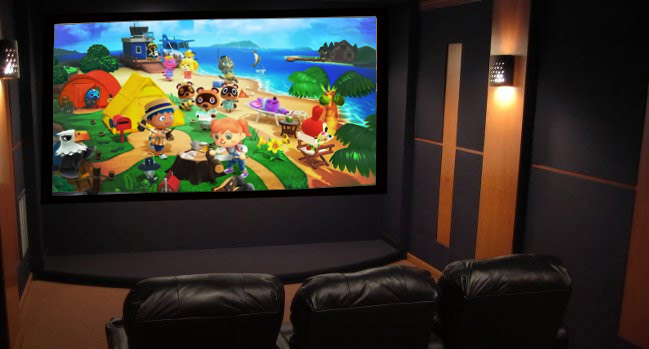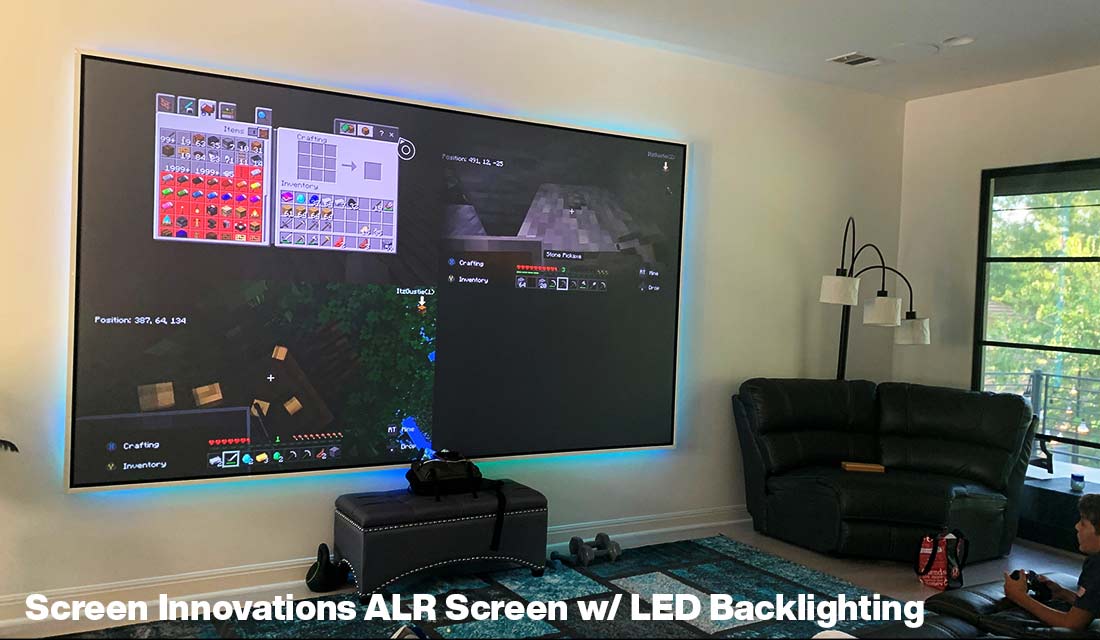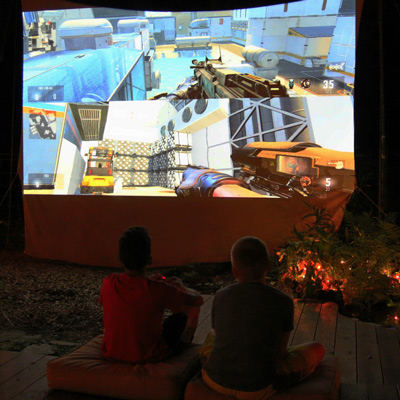Gaming Gear Buyer's Guide
Today's video games are immersive experiences with production levels that blur the line between game and Hollywood blockbuster. Game consoles like the PS4 and Xbox One have become a hub for leisure and social interaction, with Netflix and Hulu's ever-expanding HD quality content keeping smiles on the faces of the home theater connoisseur.

Projected scene from Animal Crossing® on Nintendo Switch. Check Out Our Recommended Gaming Projectors
Advancements in technology have not been limited to only gaming consoles, though. When you are a serious gamer, you want the equipment you play on to be top-notch. Smooth graphics, high quality sound, fast refresh rates and minimal lag are all important factors to consider when looking at new gaming peripherals.
Over the last few years, home theater projectors, gaming monitors and other accessories have become truly viable choices — with prices that are well within reach for the average consumer.
So which gaming equipment to opt for? Below are a few considerations to help you decide whether you'd prefer to game on a projector, dedicated gaming monitor, or traditional TV.
Looking for non-projector gaming gear? Check out our Gaming Essentials page.
Recommended Projectors for Gaming
Looking for a projector? Click here or call (888) 248-0675
Display Size
If you are looking to impress your friends with the wow factor or simply desire ultimate gaming immersion, you should definitely consider a gaming projector. They offer you the option to dial in the exact screen size you want, typically between 80 and 200 inches diagonally, depending on how far away you place it away from the wall.
Gaming monitors are a popular option as they're easier to setup and pretty much everyone has a desk or a table that can support even the largest monitors. The downside? For increased immersion, you'll need to increase the number of monitors and place them side by side. Alternatively, you can choose an ultrawide gaming monitor and avoid the distration of bezels, but you'll also need a fairly powerful graphics card to support the increased display resolution.
TVs are the default option for most console gamers out there today. Ranging in sizes from 19" to 80", they are a great choice for people that want a display for both gaming and entertainment. At larger display sizes though, the selling price starts to jump dramatically so you're often better off considering a projector.

Display Resolution
VGA and XGA projectors may be 'ok' for showing a Power Point presentation when you're at the office, but for true home entertainment, 4K UHD is the only one way to go. In the past few years, 4K UHD projectors have dramatically dropped in price, making large screen 4K projection affordable for the masses.
If you are looking for more sophisticated games that push the boundaries of the graphics engine, 4K TVs have a wide color gamut, along with HDR capabilities(High Dynamic Range). The catalog of HDR movies and TV shows is always growing, with greater highlight detail and wider color ranges to enhance your in-game and leisure viewing. There are a few dedicated gaming monitors that support HDR content as well, but those features carry with them some downside, such as lower refresh / response times.
Not surprisingly, standard 1080p (1920 x 1080) is still the dominant resolution in most households and the good news is that there are plenty of HD projectors specifically designed for home theater and gaming at affordable price points.
Does 1080p still look good at large screen sizes? Absolutely. While certainly not as crisp and detailed as 4K (3840 X 2160) resolution, HD content looks fantastic and has a film-like quality that is perfectly suited to the big screen.
Best of both worlds! With a projector, kids get to play their game and get outdoor time.

Brightness
No one wants to play their favorite horror game on a display that's washed out and hard to see or so bright it starts to hurt your eyes. Projected images tend to be less harsh compared to their TV / monitor counterparts, which can help prevent that
When determining projector brightness, the ambient light from your viewing location and the desired image size are the two most important factors to consider. Unless you're geeking out in your pitch black basement or media room, brighter is almost always better, but it will add to the cost of the projector. Start with the brightness you need and invest in a few hundred more lumens if your budget allows. Some ambient light rejecting screens made for bright rooms can help quite a bit as well, but they do cost more.
When it comes to vibrant and vivid pictures, day or not, gaming monitors and TV will give you that without the need to worry about lighting control. You'll still have to worry about glare, however, so consider the room lighting before you commit to the placement of your display. Overall, it comes down to what type of games you play and home environment.
| Brightness in Ambient Light | |
|---|---|
| Dedicated home theaters | 1500 lumens or brighter |
| Rooms with some ambient light (not directly on the image) | 2000 lumens or brighter |
| Spaces with high ambient light | 3000 lumens or brighter |
| Brightness for Screen Size | |
|---|---|
| 50-60 inch | 1000 lumens or brighter |
| 60-80 inch | 1500 lumens or brighter |
| 80-100 inch | 2000 lumens or brighter |
| 100 inches + | 2500 lumens or brighter |
Contrast Ratio
For the best image in a gaming projector, pay close attention to contrast ratios. Many of the most popular games include high dynamic color ranges allowing for very dark moments of game play. Higher contrast ratios present those shadowy scenes with greater clarity and visual acuity. In fact, a high contrast ratio often gives you a brighter looking image. Laser projectors often have higher contrast than their lamp-based counterparts but they tend to be more expensive as well.
For TVs and monitors, contrast is less of an issue as the light is pushed out to the display vs being projected onto a display. Currently, it's hard to beat an OLED television for brightness and color contrast, but newer TVs and monitors with HDR support can get pretty close.
| Contrast Ratios for Gaming | |
|---|---|
| Good | 5,000:1 or better |
| Better | 40,000:1 or better |
| Best | 100,000:1 or better |
Check out this video that provides a visual example difference between higher and lower contrast ratios »
Input Lag
Input lag is amount of time it takes for a projector (or TV, monitor) to create an image. Long input lag can make it look like your favorite TV show has bad lip-sync issues and can turn that competitive match of Call of Duty into a frustrating, controller-chucking experience.
Some amount of input lag is inevitable, as consoles and PCs ofter have to connect to third party servers for multiplayer matches. Server lag times of 50ms are not uncommon when playing online, which is not horrible, but certainly not great. If online multiplayer is your preferred arena for competitive combat, you're probably already invested in a gaming monitor since they tend to have very low input lag rates. The good news is there are a few projectors available today that also offer very low lag times; Optoma GT1080DARBEE and Optoma UHD60 4K UHD Projector are two that come to mind right away.
Most casual gamers won't even notice a bit of lag while gaming, especially if they're playing offline. If you fall into that category, any of these gaming projectors will work great. We should note, however, that most manufacturers do not measure lag time statistics for their projectors as of yet, so we are basing our current recommendations on tests done by third party sites such as projectorcentral.com , projectorreviews.com and the avs forum .
Refresh Rates
What's a refresh rate ? To put it simply, it's how fast the device can process video. A faster (higher) refresh rate means smoother, more seamless looking images. Anything over 120hz is recommended. This is not only beneficial for gaming as higher refresh rates also produce a 3D image that is 'easier on the eyes.'
As of 2020, dedicated gaming monitors remain the 'go-to' choice for hardcore PC gamers as some models support refresh rates up to 240Hz. The casual gamer will likely never need this high a refresh rate, but in competitive online matches where millisecond reactions determine who wins and loses, it can make a difference.
Most mid to high-end HD / 4K UHD televisions today have 120Hz refresh rates, whereas most budget models have 60Hz screens. For movie watching and streaming, 60 Hz is fine, though you may find some benefit to having a higher refresh rate when watching fast moving scenes, like sports or action films. Most current consoles support 120Hz however, so having a higher refresh rate can help avoid screen blur and result in a more enjoyable gaming session.
Unfortunately, this is a statistic most projector manufacturers do not provide anymore, but the good news is that most home theater projectors do pretty well in this regard anyway. That said, there are still some things you can do to improve your projector's performance:
Make sure your input resolution matches the display resolution. If you're projecting from your computer, make sure you downscale that sick 4k resolution to 1080p / 16:9 and ensure your projector is set to the same. Any scaling done on the projector will introduce a bit of lag.
Check to see if your projector has a 'gaming' or 'fast' mode. This typically reduces image quality by a small amount, but can also shave dozens of ms of lag time.
Check to see if your projector has a 'gaming' or 'fast' mode. This typically reduces image quality by a small amount, but can also shave dozens of ms of lag time.Connect directly to the projector from your game. In a lot of home theater setups, the console/pc may run through a home theater receiver first, which introduces one more thing the signal has to travel through before reaching the final display. The fastest route is also the shortest.
Below are some refresh rates for popular streaming services and gaming consoles, courtesy of rtings.com.
| Content | Frame Rate | Source | Refresh Rate |
|---|---|---|---|
| Netflix | 24 fps to 60 fps | Xbox One S/X | 24Hz to 120Hz |
| Better | 24 fps to 60 fps | PS4/PS4 Pro | 24Hz to 60Hz |
| Best | 24 fps | Blu-ray players | 24Hz to 60Hz |
| Best | 30 fps to 60 fps | PC | Up to 240Hz |
| Best | 30 fps to 60 fps | Chromecast | 60Hz |
| Best | 25 fps to 50 fps | Apple TV | 24Hz to 60Hz |
Game On
Gaming is no longer something nerdy kids do in their bedrooms; the gaming culture is vast and growing everyday. Parents game with their kids and kids game with each other — all across the world. At one time or another, every gamer has sat in the movie theater and wished they could play their favorite game on that giant screen.
And now they can. Game on.
